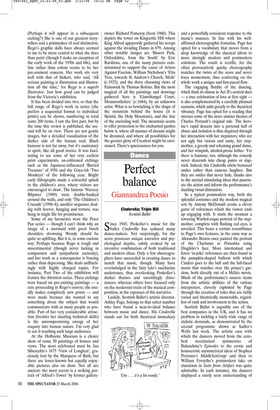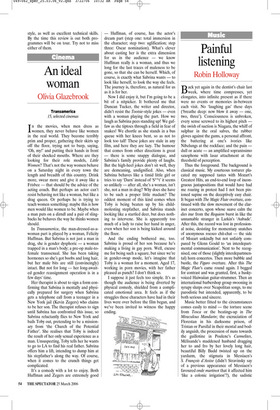Perfect balance
Giannandrea Poesio
Cinderella; Triple Bill Scottish Ballet Sce 1945, Prokofiev’s music for the inballet Cinderella has seduced many dance-makers. Not surprisingly, for the score possesses unique narrative and psychological depths, subtly evoked by an inventive combination of both traditional and modern ideas. Only a few choreographers have succeeded in creating dance to match that music, though. Many have overindulged in the fairy tale’s saccharine undertones, thus overlooking Prokofiev’s darker themes and unsettlingly dissonances, whereas others have focused only on the modernist traits of the musical composition, at the expenses of the narrative.
Luckily, Scottish Ballet’s artistic director, Ashley Page, belongs to that select number who have found a near-to-ideal balance between music and dance. His Cinderella stands out for both theatrical immediacy and a powerfully consistent response to the music’s nuances. In line with his wellaffirmed choreographic formulae, Page has opted for a vocabulary that moves from a deep knowledge of the classical idiom to more daringly modern and postmodern solutions. The result is terrific, for the often provocatively quirky choreography matches the twists of the score and never loses momentum, thus conferring on the whole work a unique and fast-paced flow.
The engaging fluidity of the dancing, which finds its climax in Act II’s central duet — a true celebration of love at first sight is also complemented by a carefully planned scenario, which adds greatly to the theatrical vibrancy. Page has opted for a reading that stresses some of the more sinister themes of Charles Perrault’s original tale. The heroine’s rapid descent into a personal hell of abuse and isolation is thus depicted through her interaction with her stepsisters, who are not ugly but vicious and nasty, her stepmother, a greedy and scheming grand dame, and her wimpish, alcohol-prone father. Yet there is humour, too, although the comedy never descends into cheap panto or slapstick. Indeed, this Cinderella elicits bemused smiles rather than raucous laughter. But they are smiles that never fade, thanks also to the myriad stimulating ideas that punctuate the action and inform the performance’s dazzling visual dimension.
In a typical postmodern way, both the splendid costumes and the modern magical sets by Antony McDonald create a clever game of references which the viewer ends up engaging with. It starts the moment a towering Warhol-esque portrait of the stepmother, complete with flashing red eyes, is unveiled. This bears a certain resemblance to Page’s own features, in the same way as Alexandre Benois once painted the portrait of the Charlatan in Petrushka using Diaghilev’s face. More intertextual and fewer ‘in-joke’ references are then found in the pumpkin-shaped balloon with which Cinders goes to the ball and the full-faced moon that watches over the prince’s gardens, both directly out of a Méliès movie. Much of the performance’s success stems from the artistic abilities of the various interpreters, cleverly exploited by Page through the creation of roles that are richly varied and theatrically memorable, regardless of rank and involvement in the action.
Scottish Ballet is arguably one of the best companies in the UK, and it has no problem in tackling a fairly wide range of stylistic demands, as demonstrated by the second programme shown at Sadler’s Wells last week. The artistic ease with which the dancers moved from the cerebral neoclassical symmetries of Balanchine’s Episodes to the erotic and homoerotic asymmetrical ideas of Stephen Petronio’s MiddleSexGorge and then to William Forsythe’s postmodern take on classicism in Suite from Artifact was quite admirable. In each instance, the dancers displayed a rarely seen understanding of style, as well as excellent technical skills. By the time this review is out both programmes will be on tour. Try not to miss either of them.
























































 Previous page
Previous page